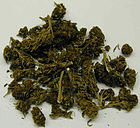Note: This is a project under development. The articles on this wiki are just being initiated and broadly incomplete. You can Help creating new pages.
Difference between revisions of "Cannabis sativa - Bahuvadini"
(→External Links) |
(→Commonly seen growing in areas) |
||
| Line 43: | Line 43: | ||
==Commonly seen growing in areas== | ==Commonly seen growing in areas== | ||
| − | {{Commonly seen| | + | {{Commonly seen| |
| − | + | Houseplant}}, {{Commonly seen|sea coast}}, {{Commonly seen|landscape}}. | |
==Photo Gallery== | ==Photo Gallery== | ||
Revision as of 12:17, 12 April 2018
Bahuvadini or Cannabis sativa is an annual herbaceous plant in the Cannabis genus, a species of the Cannabaceae family. People have cultivated Cannabis sativa throughout recorded history as a source of industrial fibre, seed oil, food, recreation, religious and spiritual moods, and medicine. Each part of the plant is harvested differently, depending on the purpose of its use.
Contents
Uses
Cancer, Glaucoma, HIV/AIDS, Muscle spasms, Seizures, Severe pain, Severe nausea.
Parts Used
Chemical Composition
Most varieties contain cannabinol and cannabinin; Egyptian variety contains cannabidine, cannabol and cannabinol, their biological activity being due to the alcohols and phenolic compounds. Resin contains crystalline compound cannin. Alcoholic extracts of American variety vary considerably in physiological activity[1]
Common names
| Language | Common name |
|---|---|
| Kannada | bhangi, bhangi gida |
| Hindi | bhang, ganja, charas |
| Malayalam | cherukanchava, ginjilachilachi |
| Tamil | alatam, ananta muli |
| Telugu | bangiaaku, bangiaku, gaanja chettu |
| Marathi | NA |
| Gujarathi | NA |
| Punjabi | NA |
| Kashmiri | NA |
| Sanskrit | bahuvadini, banga |
| English | Marijuana, Hemp, Gallow grass |
Habit
Identification
Leaf
| Kind | Shape | Feature |
|---|---|---|
| alternate | stipulate | long petiolate, palmate, with 3-11, rarely single, lanceolate, serrate, acuminate leaflets up to 10 cm long, 1.5 cm broad |
.[2]
Flower
| Type | Size | Color and composition | Stamen | More information |
|---|---|---|---|---|
| monoecious | 2.5 cm long | yellowish | 5 poricidal stamens | the female flowers germinate in the axils and terminally, with one 1-ovulate ovary; fruit a brown, shining achene, variously marked or plain, tightly embracing the seed with its fleshy endosperm and curved embryo, Flowering season is summer |
Fruit
| Type | Size | Mass | Appearance | Seeds | More information |
|---|---|---|---|---|---|
| short legume | 7-9 cm | late summer to early fall; year round in tropics | Seeds weigh 1.5-2.5 gm/100 seeds. | {{{5}}} | {{{6}}} |
Other features
List of Ayurvedic medicine in which the herb is used
- Vishatinduka Taila as root juice extract
Where to get the saplings
Mode of Propagation
How to plant/cultivate
Propagation mainly by seed. Experimentally, drug plants have been propagated from cuttings but such plants do not come true as to drug content of parent. Seeds stored in cool, dry place remain viable for up to two years. Hemp seed sown as early in spring as possible. Before sowing, land is plowed (in fall) several times to a depth of about 20-23 cm and repeatedly harrowed the land. In spring the land is harrowed again and rolled, making a firm tilth over the entire surface. In some areas a first plowing is done in the fall and red clover or lupin planted; in January or February a second plowing turns these under as a green-manure[3]
Commonly seen growing in areas
[[:Category:Herbs that are commonly seen in the region of Houseplant| Houseplant]][[Category:Herbs that are commonly seen in the region of Houseplant]], sea coast, landscape.
Photo Gallery
References
External Links
- Pages that are stubs
- Ayurvedic Herbs known to be helpful to treat Cancer
- Ayurvedic Herbs known to be helpful to treat Glaucoma
- Ayurvedic Herbs known to be helpful to treat HIV/AIDS
- Ayurvedic Herbs known to be helpful to treat Muscle spasms
- Ayurvedic Herbs known to be helpful to treat Seizures
- Ayurvedic Herbs known to be helpful to treat Severe pain
- Ayurvedic Herbs known to be helpful to treat Severe nausea
- Herbs with Seed used in medicine
- Herbs with Leaves used in medicine
- Herbs with common name in Kannada
- Herbs with common name in Hindi
- Herbs with common name in Malayalam
- Herbs with common name in Tamil
- Herbs with common name in Telugu
- Herbs with common name in Sanskrit
- Herbs with common name in English
- Habit - branched shrub
- Index of Plants which can be propagated by Seeds
- Herbs that are commonly seen in the region of sea coast
- Herbs that are commonly seen in the region of landscape
- Herbs








